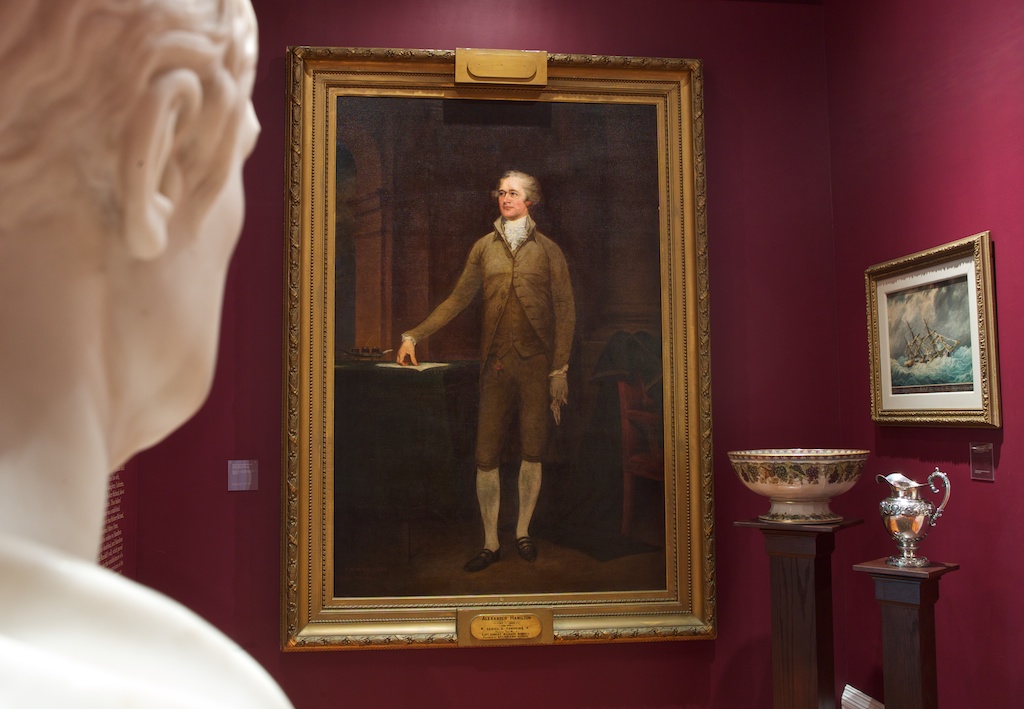
June 30, 2012 - 2015
Treasures of Sailors' Snug Harbor, an exhibition of art and artifacts from the Collection of the Trustees of the Sailors' Snug Harbor in the City of New York, opened on June 30, 2012 and will continue through 2015.
It consists of work from Sailors' Snug Harbor, the famous old home for mariners, on the Staten Island shore of the Kill van Kull. From 1831 until the facility moved to North Carolina in 1976, it amassed a noteworthy collection of fine art and artifacts in the many buildings and on the grounds of the 80-acre campus.
The Sailors' Snug Harbor Trust remains in existence and continues to provide financial assistance to eligible mariners around the country. In 2010, the Trustees of the Sailors' Snug Harbor in the City of New York selected the Noble Maritime Collection as the steward of its collection and placed many works of art, furnishings, and artifacts on loan at the museum. Though the works of art graced the halls of the private facility for over 100 years, they had not been exhibited for the public.
In addition to a 1894 impressive full-length, 5’ x 7’ portrait of Alexander Hamilton by Thomas Waterman Wood (1823-1903) after the original painting by John Trumbull (1756-1843), works of art range from large canvases such as Gustav Romin’s 6’ x 8’ oil, Fishing off the Coast; a 4’ x 7’ 19th Century American School oil called A View of Upper Bay, which features the Narrows and the Staten Island and Brooklyn shorelines; and H. Cassinelli’s The Shakespeare in a Storm, a 3.5’ x 4’ oil painting.
Several early seascapes and ship portraits are featured. The nineteenth century works include, from the Chinese School, The Luzor in a Swell; and from the French School, The Corra Linn, and The Louis Phillippe Caught in a Gale, a watercolor and gouache done in 1843 by Frederic Roux (1805-1874).
The exhibition features paintings by James Stuart Blackton (1875-1941), Samuel Finley Morse Badger (1873-1919), William Lindsay Challoner (1852-1901), and the prolific and renowned ship artist, Antonio Nicolo Gasparo Jacobsen (1850-1921). Two works by Jacobsen are featured, The Venezuela at Sea and Flourine, Argenta and Iodine at Sea.
Though little is known about E.F. Neilson, who died prior to 1928, several of his paintings are in the Collection. It is believed that he worked and possibly lived on Staten Island, and the exhibition features his paintings of local subjects, Stapleton Anchorage, Staten Island and Columbus Day Naval Review, New York Harbor, with U.S.S. New York, as well as his dramatic composition, An American War Ship Engaging a British War Ship.
Several works that reflect the history of Sailors' Snug Harbor, such as the Marble Bust of Robert Richard Randall by Robert Eberhard Schmidt Von Der Launitz (1806-1870) and Randall’s cane, which he left to the overseer of his farm in Manhattan in his famous will, will be displayed. Robert Richard Randall died in 1801 and left his Manhattan estate, Minto Farm, to trustees delegated to establish a home for “aged, decrepit, and worn-out seamen.”
The stained glass transom window by John La Farge (1835-1910) that graced the first building on the site, Main Hall, which opened in 1831, is exhibited, as well as a Letter of Safe Passage signed by President Thomas Jefferson and Secretary of State James Madison in 1802.
Sailors' Snug Harbor commissioned portraits of its governors, as the facility’s directors were called, and included in the collection are the Thomas Pollock Anschutz (1851–1912) Portrait of Captain Gustavus D.S. Trask, and a Portrait of Governor Thomas Melville by George Gerhard (1830-1902). Thomas is the brother of author Herman Melville (1819-1891) and served as governor of Sailors' Snug Harbor from 1867 until his death in 1884.
Alluding to the several architecturally significant buildings no longer on the Staten Island campus, a watercolor called Church and Music Hall at Sailor’s Snug Harbor features the Randall Memorial Church, a replica of St. Paul’s Cathedral, London, that was demolished in 1952. Also displayed are altar rails and part of the hand-carved frieze that graced the church interior.
The Marine Society of the City of New York and the Trustees of the Noble Maritime Collection provided significant funding to conserve the works of art. The exhibition was also funded by the Staten Island Foundation, the Achelis and Bodman Foundations, the Trustees and members of the Noble Maritime Collection, and the New York City Department of Cultural Affairs in partnership with the City Council. The Noble Maritime Collection is greatly appreciative of the opportunity offered by the Trustees of the Sailors' Snug Harbor in the City of New York to publicly exhibit the historically significant art and artifacts in their collection.
©2013 The Noble Maritime Collection all rights resrved
